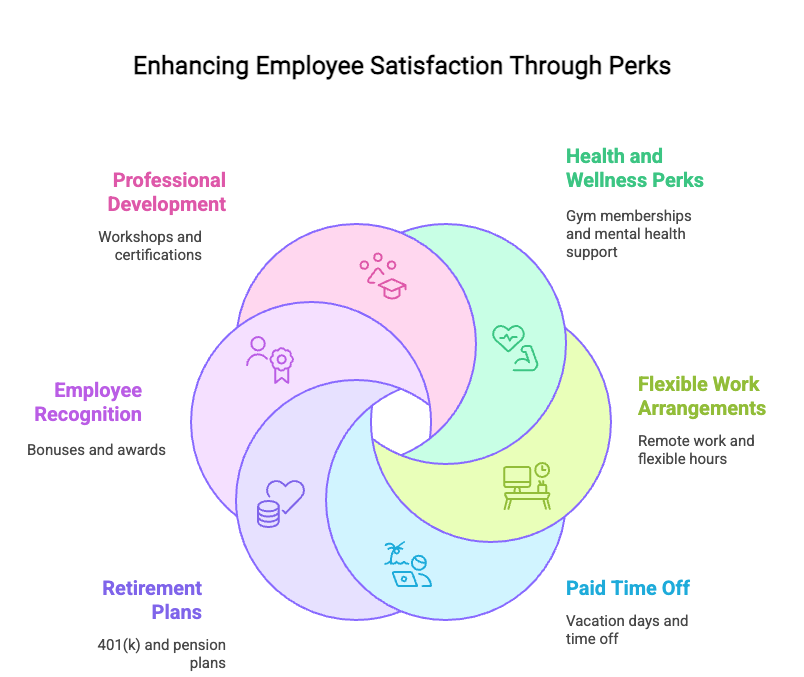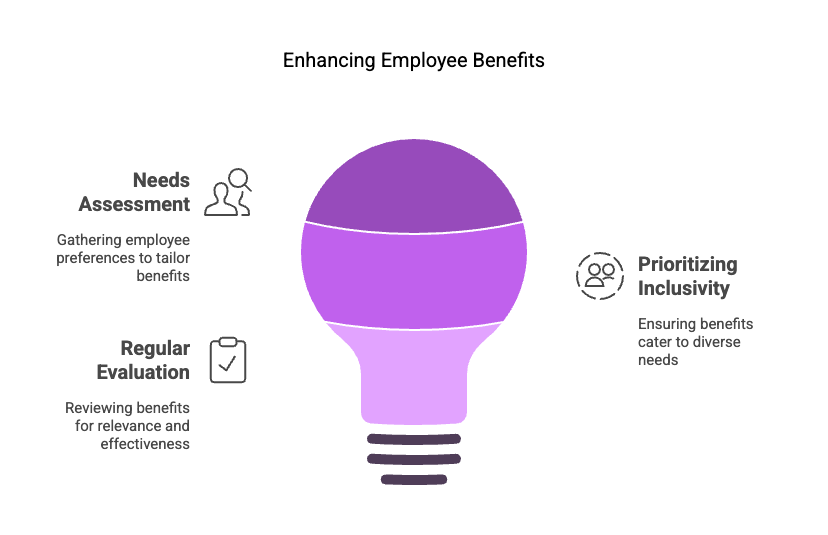Key Takeaways:
- Thoughtful employee benefits and perks improve satisfaction, retention, and productivity.
- Wellness programs, flexible work, and PTO are among the most valued perks across industries.
- Personalized and inclusive perks create a stronger sense of belonging and motivation.
- Regularly evaluating and updating benefits ensures they stay relevant and impactful.
- Measuring success through KPIs like satisfaction scores and retention rates helps refine strategies.
If you’ve noticed that employee satisfaction is going down while turnover rates are on the rise, it might be time to think of new workforce strategies. Providing personalized and thoughtful perks will help you turn things around and create a workplace that your team truly values.
This article will guide you through the most effective employee benefits and perks to boost morale, retain talent and create a workplace your team values.
Which Perks Contribute to Employee Satisfaction?
No matter the industry you work in — hospitality, tech, healthcare, finance or retail —employees value similar perks that contribute to their job satisfaction.
Health and wellness perks
Gym memberships, mental health counseling or wellness stipends show employees that you think of their well-being, which boosts their morale, decreases absenteeism, and improves overall productivity.
Flexible work arrangements
Flexible work arrangements such as remote work, flexible hours and compressed workweeks, allow employees to adapt their schedules and work locations to fit their needs and have more control over their work-life balance.
Paid time off (PTO) and vacation days
Paid time off and vacation days give employees the opportunity to recharge, which helps them avoid burnout and stay motivated and productive, increasing the likelihood of staying with the company long-term.
Retirement plans
Retirement plans, such as a 401(k) or pension plans, show employees that the company cares about their financial well-being, helping them plan for the future with peace of mind, reducing financial stress and increasing job satisfaction.
Employee recognition and rewards programs
Recognition of employee achievements through bonuses, awards or public acknowledgment recognizes hard work and makes employees feel valued and appreciated, encouraging them to perform at their best.
Professional development and learning opportunities
Encouraging employees to grow their skills through workshops, certifications or online courses demonstrates a company's interest in their development, enhancing engagement and retaining top talent.
The Impact of Employee Benefits
Offering a comprehensive package of employee benefits and perks brings various advantages to employees and employers.
Boosting employee morale
Feeling supported through thoughtful perks increases engagement and motivation. This positivity can create a ripple effect, building a collaborative and enthusiastic work environment.
Enhancing employee retention
Employee benefits can play a key role in keeping talent as they see that their needs are being met. This makes them loyal to your company, leading to a more cohesive and experienced workforce.
Attracting top talent
Offering unique employee benefits is likely to catch the attention of skilled candidates as job seekers often consider the overall benefits package when evaluating potential employers.

Strategies for Implementing Unique Employee Benefits
Implementing unique employee benefits in your company requires a thoughtful approach, which takes into consideration your company’s goals and your employees' needs.
Conduct a needs assessment
Ask employees about their preferences and see what else you can offer on top of your current benefits.
Prioritize inclusivity
Think of perks that cater to a diverse workforce with varying lifestyles, family situations and personal preferences. This approach will create a sense of belonging and ensure all employees feel valued.
Regularly evaluate benefits
Review the perks you offer on a regular basis to ensure they remain relevant and effective. This can involve collecting feedback from employees and analyzing industry trends to stay ahead of the curve.

Measuring the Success of Employee Benefits
To ensure that your employee benefits program is delivering the desired impact, you should be able to measure its effectiveness.
Key performance indicators
Set key performance indicators (KPIs). These may include:
- Employee satisfaction scores: Regular surveys can gauge how satisfied employees are with their benefits.
- Retention rates: Monitoring turnover can provide insights into the impact of perks on employee loyalty.
Collect employee feedback regularly, monitor industry benchmarks and stay aware of emerging trends like financial wellness programs or fertility benefits to stay competitive and be able to attract top talent.
Conclusion: The Future of Employee Benefits for Your Organization
Unique employee benefits are key for building a positive workplace culture and enhancing employee satisfaction. By understanding what employees value, you can offer benefits that meet their needs, while at the same time attracting and retaining top talent.









Loading comments...